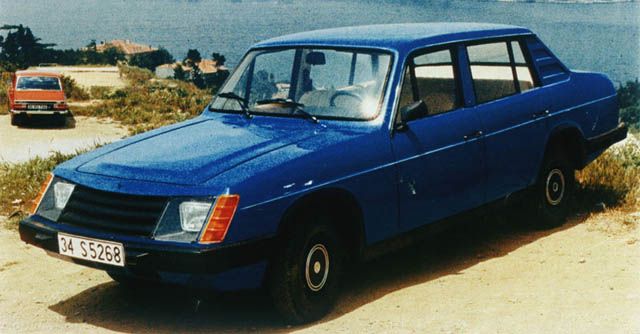In the early 1980s, Turkey’s automotive landscape stood at a crossroads. While global manufacturers dominated the international market, one domestic brand dared to challenge the status quo. The Anadol 16, launched in November 1981, represented both the culmination of Turkish automotive ambition and the end of an era.
This final iteration of Turkey’s pioneering car brand emerged during a transformative period in automotive history. As manufacturers worldwide embraced computer-aided design and automation, Anadol chose a path that blended traditional craftsmanship with modern engineering principles.
Legacy of Turkish Innovation
The journey of Anadol mirrors Turkey’s industrial evolution. In a market dominated by imported vehicles, Otosan’s decision to develop a domestic car brand demonstrated remarkable foresight. The A8 16 model, in particular, showcased the company’s ability to adapt international standards to local needs.
This ambitious project represented more than just automotive engineering — it embodied national pride and industrial capability. The development process involved collaboration with international partners while maintaining distinctly Turkish design elements.
“The Anadol 16 wasn’t just another car; it was a statement of Turkish industrial capability. Each unit represented countless hours of engineering refinement and national pride,” recalls Dr. Mehmet Yilmaz, former lead engineer at Otosan.
The vehicle’s design philosophy reflected a deep understanding of the local market while incorporating international standards. This balance between domestic needs and global aspirations set Anadol apart from its predecessors.
Historical Reference!
Before Anadol, Turkey's only attempt at domestic car production was the Devrim in 1961, which never reached mass production. Anadol changed this narrative, proving that sustained domestic automobile production was possible.
Design Philosophy & Engineering
The Anadol 16’s design drew inspiration from contemporary Scandinavian automobiles, particularly Saab and Volvo models. This influence manifested in clean lines and practical aesthetics that distinguished it from other vehicles in its class.
At the heart of the A8 16 beat the reliable Ford Kent Crossflow OHV engine, delivering 65 horsepower in the base model and 70 horsepower in the upscale SL variant. This power plant, combined with a four-speed manual transmission, enabled a respectable top speed of 150 kilometers per hour.
Engineering highlights that defined the Anadol 16 include:
- longitudinally mounted engine providing optimal weight distribution;
- rear-wheel drive configuration enhancing handling characteristics;
- robust leaf spring suspension system designed for Turkish road conditions;
- spacious interior accommodating five passengers comfortably;
- reinforced chassis structure ensuring durability in various conditions.
These technical choices reflected a deep understanding of local driving conditions and user needs.
Fact!
The Anadol 16 SL variant featured upgraded interior appointments and improved performance, making it the most sophisticated Turkish-produced automobile of its era.
Market Impact & Production
The production run of 1,013 units tells a story of careful manufacturing and market positioning. Between November 1981 and January 1984, each Anadol 16 represented a step forward in Turkish automotive capability.
“I remember when the first Anadol 16 rolled off the production line. The entire factory felt like we were making history. Each car was assembled with extraordinary attention to detail,” shares Ahmet Kaya, former production supervisor at the Otosan plant.
The initial release of 300 base model units allowed Otosan to gauge market response and refine production processes. The subsequent 713 SL variants incorporated improvements based on early customer feedback and real-world performance data.
Market reception exceeded expectations, particularly among urban professionals seeking a distinctive yet practical vehicle. The Anadol 16’s combination of modern features and local serviceability made it an attractive proposition for discerning buyers.
Collector’s Perspective
Today, the Anadol 16 commands respect among classic car enthusiasts. Surviving examples, particularly the SL variant, represent significant pieces of automotive history. Their rarity and historical importance make them increasingly valuable collector items.
Restoration experts note the vehicle’s robust construction and relatively straightforward mechanical layout. However, sourcing specific components can prove challenging, adding to the car’s mystique among collectors.
Notice!
Original Anadol 16 parts are increasingly rare, with many collectors maintaining networks across Turkey and Europe to source authentic components.
The preservation community has documented approximately 200 surviving examples, with fewer than 50 in concours condition. This scarcity has only enhanced the model’s desirability among automotive historians and collectors.
The Road Ahead
The Anadol 16’s legacy extends beyond its production numbers. As Turkey’s automotive industry continues to evolve, this pioneering model serves as a reminder of the country’s early achievements in domestic vehicle production.
Modern Turkish automotive projects often reference the Anadol 16 as inspiration, acknowledging its role in establishing the foundation for contemporary manufacturing capabilities.
| Pros | Cons |
|---|---|
| Historical significance as Turkey’s final domestically designed passenger car | Limited production run affecting parts availability |
| Robust Ford-sourced powertrain with proven reliability | Performance modest by modern standards |
| Distinctive Scandinavian-influenced design | Restoration challenges due to scarcity of components |
| Strong collector value and investment potential | Limited technical documentation available |
| Cultural importance in Turkish automotive history | Rust-prone body panels in certain areas |
| Comfortable interior with good visibility | Basic suspension system by contemporary standards |
| Serviceable mechanical layout | Limited export market presence |
The Anadol 16 represents more than just another entry in automotive history. It stands as testament to Turkey’s industrial ambition and engineering capability during a pivotal period of development. While production numbers remained modest, its impact on the nation’s automotive sector continues to resonate. For collectors and enthusiasts, the Anadol 16 embodies a unique combination of historical significance, technical innovation, and cultural heritage that makes it an increasingly valuable piece of automotive history.

